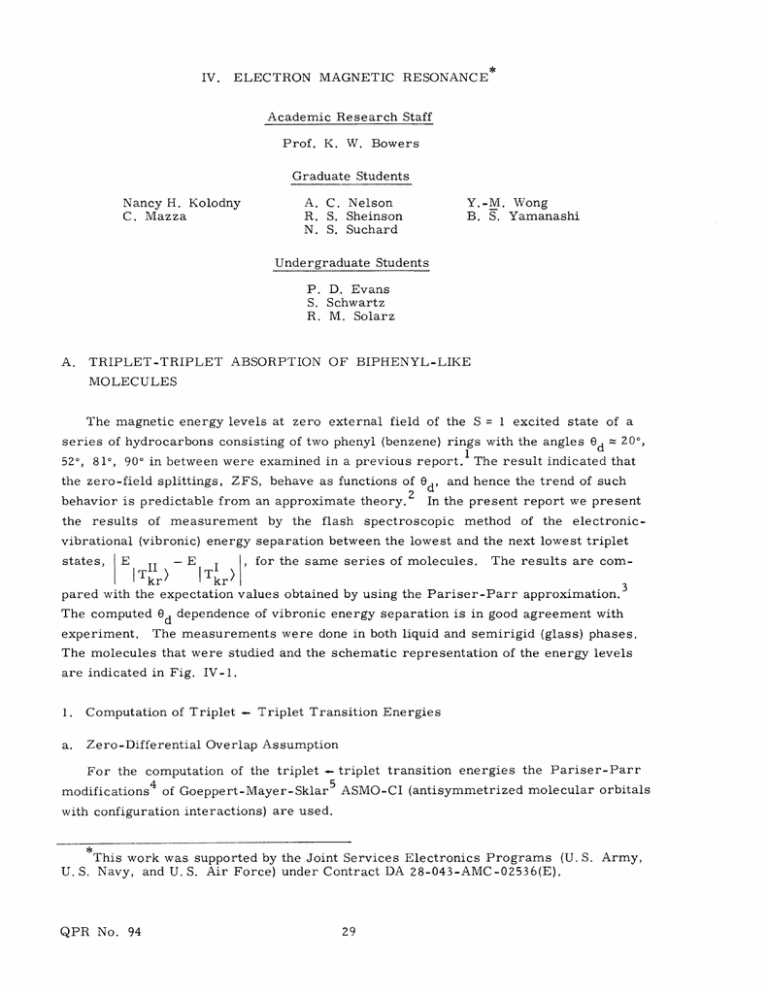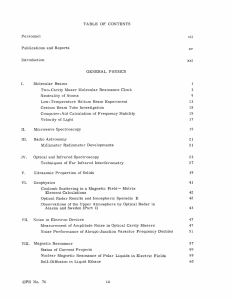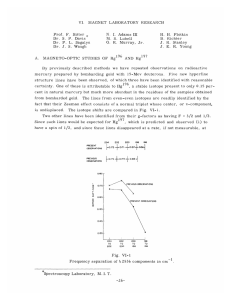IV. ELECTRON MAGNETIC RESONANCE Academic Research Staff
advertisement

IV. ELECTRON MAGNETIC RESONANCE Academic Research Staff Prof. K. W. Bowers Graduate Students Nancy H. Kolodny C. Mazza A. C. Nelson R. S. Sheinson N. S. Suchard Y.-M. Wong B. S. Yamanashi Undergraduate Students P. D. Evans S. Schwartz R. M. Solarz A. TRIPLET-TRIPLET ABSORPTION OF BIPHENYL-LIKE MOLECULES The magnetic energy levels at zero external field of the S = 1 excited state of a series of hydrocarbons consisting of two phenyl (benzene) rings with the angles 520, 810, 900 in between were examined in a previous report. 1 0 d = 200, The result indicated that the zero-field splittings, ZFS, behave as functions of 0 d and hence the trend of such 2d' behavior is predictable from an approximate theory. In the present report we present the results of measurement by the flash spectroscopic method of the electronic- vibrational (vibronic) energy separation between the lowest and the next lowest triplet states, - E E , for the same series of molecules. The results are com- T) rr T3 3 pared with the expectation values obtained by using the Pariser-Parr approximation. The computed experiment. 0 d dependence of vibronic energy separation is in good agreement with The measurements were done in both liquid and semirigid (glass) phases. The molecules that were studied and the schematic representation of the energy levels are indicated in Fig. IV-1. 1. Computation of Triplet - a. Zero-Differential Overlap Assumption Triplet Transition Energies For the computation of the triplet - triplet transition energies the Pariser-Parr modifications 4 of Goeppert-Mayer-Sklar 5 ASMO-CI (antisymmetrized molecular orbitals with configuration interactions) are used. This work was supported by the Joint Services Electronics Programs (U. S. Army, U. S. Navy, and U. S. Air Force) under Contract DA 28-043-AMC-02536(E). QPR No. 94 FLASH SPECTROSCOPY (PRESENT REPORT) ITkr> ELECTRON RESONANCE (cf. Yamanashil 3 5x 10 (Oe) 0 SO) ) (a) BIPHENYL 10 9 11 7 2 1 4 12 5 8d ~520 d - 200 ° d~0 - 10 C d,- 810 d~ 900 (b) Fig. IV-1. (a) Schematic diagram of the vibronic (left) and the magnetic energy levels of biphenyl. Abs. = absorption of photon(s) Fluor. = fluorescence Phos. = phosphorescence IC = internal conversion ISC = intersystem crossing kr ) = first triplet electronic manifold resulting from electron promotion of the type k - r Skt) = first singlet electronic manifold resulting from electron promotion of the type k - r SO) o +1), = ground state 0), -1) = electronic spin eigenstate in an external magnetic field. (b) Molecules with twist angle transitions are examined. QPR No. 94 0 d for which TI Tkr (IV. ELECTRON MAGNETIC RESONANCE) Let LCAO-MO (linear combination of atomic orbitals) be represented as (1) k) = ICkpXp p where subscript k labels the MO, and p runs over the AO. The triplet electrons i and j are "viewed" as "sitting" on the core consisting of the paired electrons and nuclei. Thus the Hamiltonian takes the form k S= i where r. (2) e c ore + 2-1 i ji 1 is the separation between electrons i and j. For the interactions between these two electrons matrix elements of the following general form must be considered. In the short notation, they are (3) r(i)d(j)) ' k(J) [kr df] = (f(i ij i j i where k, r, d, f label the MO. Substitution of (1) in (3) yields (4) CkpCrmCdqCfm(pm qn), [krl df] = pmq n where 2 (pm qn) = (Xp(i)n() e (5) Xm(i)Xq(j)) Here we may consider the matrix element (5) as the and p, m, q, n are different AO. energy of interaction between two charge distributions eXpXm and eXqXn. The Pariser- Parr assumption is if p XpXm = 0 (6) m, where the star indicates the complex conjugates in an alternant hydrocarbon. Equation 6 is equivalent to saying that repulsions between electrons are described by the properties of just two of the atomic centers and that differences caused by small changes in the bondings of the atoms can be neglected. (pm qn) = (see Fig. IV-3). QPR No. 94 6 6 qn(ppqq) 6 With this assumption (5) transforms to pmqn Xpq (7) (IV. ELECTRON MAGNETIC RESONANCE) Substitution of (7) in (4) gives [kr Idf] CkpCrqCdqCfqXpq = pq Specific types used in the evaluation of triplet-triplet energy level separation are the Coulomb repulsion integral Jkr and the exchange integral Kkr* Using (8), we may define these integrals as Ckp CkqC rq rq rXpq [kk rr] = Jkr p q [kr kr] = kr CkpC rq Ckq C rq Xpq P q X R pq pq has been determined for the carbon atom as a function of internuclear separation . For R pq greater than 2. 8 A, Xpq= (7. 1975/R pq) pqp For R pq X -1/2 j 2 +(1+2. 0007/Rp) eV eV. (10) less than 2. 8 A Pq = 10. 53 - 2. 625R Pq + 0. 2157R 2 pq (11) eV, where in the specific case of biphenyl-like molecules 6 with the twist angle and q atoms are on different phenyl rings, Rpq is a function of R pq(d) = with "+" R 5. 8 sin2 ( 0 d/2) R pq(0d=0) for p = 2 or 3 and q = 8 or 9, and "-" 0 Gd' when p d with the relations 1/2 for p = 2 or 3 and q = 11 or 12. (Od) = Rpq (d=00) for p, q with any other assignment than those above. (See Fig. IV-lb for the numerical assignment of p and q for each atomic position.) The resonance terms p follows pq for carbon have been given as a function of R 3pq = -6442 exp(-5. 6864R pq) QPR No. 94 eV. pq as (12) (IV. ELECTRON MAGNETIC RESONANCE) Reasonably accurate values of C.. can be readily obtained by simple HMO calculations. If more accuracy is desired, other methods such as extended HMO-SCF (Hiickel molecular orbital with self-consistent field) could be employed. Triplet Transition Energies in Alternant Hydrocarbons b. 7 By the use of pairing theorems and some algebra it can be shown that =E -E E SO o TN kr -E N rk So o = X r + k -J kr (13) where k- (14) Kf, k(d) W-k(-P) + f and K f (15) PpqCp C rqXp (d). (d) = 21 f, k(d) pqkp rq pq pq state (N, M refer to different electronic maniHere, E N is the energy of the ITr) T kr folds) resulting from the promotion of an electron from the orbital k to the orbital r. is the energy of the ground state, W_-k(-) E refers to the eigenvalues of the Hiickel o Ppq is the bond order for the p-q bond defined as approximation, P . C n C m mp mq =pqL, (16) m When m is summed over all occupied orbitals and nm is the number of electrons in the m th orbital (16) is simply P pq =6 (17) pq In (14) and (15) " (d)" means that summations are taken only over those combinations of p and q such that atoms p and q belong to different pairing sets. Then it follows from the perturbation argument that E T Mkr QPR No. 94 - E T N+ kr = 2K kr (18) eV and Triplet transition energies in Table IV-1. (cm 3 A2 0d = K12 4 K13 K14 AE' 100 0. 5004 (4030) 3. 2295 (26,800) 0. 2327 (1877) 0. 6619 (5335) 3. 1535 (25,400) 300 0. 6180 (4980) 3. 5784 (28,800) 0. 1653 (1333) 0. 1654 (13,030) 3.3168 (26,700) 500 3. 4397 (27,700) 0. 1476 (1190) 1. 7066 (13,740) 4. 3585 (35,200) 600 3. 3818 (27,300) 0. 1371 (1106) 2. 4387 (19, 630) 4. 7430 (38,200) 3.3996 0. 1266 (1040) 2.8013 (22, 630) 5. 2888 (42, 600) 3.4409 (27,700) 0. 1175 (947) 3. 1788 (25,400) 3. 5596 (28,700) 3. 2886 (26, 500) 0. 1140 (918) 3.3615 (27, 100) 6. 6647 (53,700) x 0 o 70(27,400) 0. 0389 (312) 800 symbol Ar E IIIr = - E P(W-r-W- 1)+ (J l-J K- AWr-1 r-1 + = K lrIr Kk- [kr Ikr] = Z Z C k qkp AE'E E II 14 lr)+ T11 E I 14 =A C 4 rq -A 2 C kq X + 2K pq J rr1 + A f Kfr- Z Kf1) fl Kfr. (cf. (10) and (11)). 1122 . f = No possible transitions, since the transition has negative energy. * = Average of the K... Ii QPR No. 94 ELECTRON MAGNETIC RESONANCE) (IV. Equation 18 allows one to calculate the energy levels of all of the triplet states Tkr ' Selection rules for electronic and hence the energies of triplet-triplet transitions. transitions are the following. IT N - ) M+ (i) Only transitions of the type IT IS° ) (ii) The ground state are allowed. acts ITNk) as a minus state; acts as a plus state. (iii) No configuration interaction occurs between plus and minus states. 3.0 K 2.5 - 2.0 z z 1.5 Z = A0 T14 T+11 14- 14 z - 1.0 0.5 k- X T 12._T12 TI2 O T4 * T T 12- I I 10 20 30 I I 40 50 60 _ T11 T 14- 70 11 80 90 &d (Deg.) Fig. IV-2. Comparison of possible transition energies as functions of the twist angle 0 d. Note that the A' s (T14 respond well with A's and Fig. IV-5. T 1 1 transition) cor- O's in the experimental plots of The result of the computations for biphenyl, compounds A, B, C, D are indicated in Table IV-1, and Fig. IV-2. in Fig. IV-3. QPR No. 94 A plot of the Pariser-Parr (ppjqq) against Rpq is shown (IV. ELECTRON MAGNETIC RESONANCE) Rp Fig. IV-3. 2. Experiment a. Apparatus (A) Pariser-Parr values for (pplqq). The apparatus is diagrammatically indicated in Fig. IV-4. The special feature of this apparatus is that it allows the sample to form a glass in the reaction cell so that we can take spectra of the sample both in solution and in glass. All other parts are similar to those of Porter et al. b. Settings The photoflash was typically charged to 5 kV at 75 p.F; the spectroscopic flash was used at 2. 5 kV at 4 fxF. QPR No. 94 Kodak XXX film was used in segments of appropriate length for TRIGGER UNIT QUARTZ SAMPLE CELL QUARTZ DEWAR CYLINDRICAL QUARTZ LENS COLLIMATORS HILGER WATT MED. QUARTZ SPECTROGRAPH PHOTOLYSIS FLASH TUBE DC 0-10 kV PWR SUPPLY 4 pF CAPACITOR BANKS (a) FUNNEL FOR LIQUID NITROGEN SAMPLE CELL -NITROGEN INLET TRIGGER WIRE TO CAPACITOR BANK XENON-FILLED PHOTOLYSIS FLASH PLEXIGLAS COVER MAIN TRIGGER UNIT OPTICAL RAIL Fig. IV-4. QPR No. 94 (a) Diagram of the flash spectrographic apparatus for studying vibronically excited molecules. (b) Detail of the photolysis cell unit. ELECTRON MAGNETIC RESONANCE) (IV. the Hilger and Watts medium quartz spectrograph. Each film strip was utilized for 5 spectra made by three to five exposures. The spectrographic flash was set to delay the -6 sec. D-76 developer and standard fixer were used. photolysis flash by 10 c. Samples B - 1, 2, 3, 4-dibenz- The samples were biphenyl, A - 9, 10 -dihydrophenanthrene, 1, 3-cycloheptadiene-6-one, C = 1, 2, 3, 4-dibenz-1, 3-cyclo-octadiene-6-one, D All but one (methyl cyclohexane is used for B in the liquid phase) of the bimesityl. samples were flashed in EPA in both liquid and glass phases. The concentrations of all samples were 0. 001 M, except for the compound C which was diluted to 5 X 10-5 M because of its scarcity. d. Recording of Spectra The spectra on film, developed and fixed, were read by precalibrated microdensitometer. Xenon emission lines were subtracted from the spectra. The correlation of specific lines for different samples were made by combined criteria of (i) wavelength region, (ii) intensity and (iii) comparison of liquid and glAss phase spectra. The experimental results are exhibited in Table IV-2 and Fig. IV-5. 3. Discussion of Results Comparing the computational results, in Table IV-1 and Fig. IV-2, with the experimental results in Table IV-Z and Fig. IV-5, we first notice the marked resemblance of the computational A 4 (with symbol A) as a function of 0 d and the experimental absorption peaks occurring in the 4200 ~ 4300 A region (marked by A) recorded for compounds with different 0 d (biphenyl, A, B, C, and D). The agreement in both the general trend and the energy values implies that for this particular transition the assumption XpXm = 0 for p * m is not unreasonable, and we can tentatively assign the transition to the type 14 T 'll) The change in the general behavior of the transition occurring in the 4800 ~ 5100 A region (marked by 0) with respect to 0 d , when the temperature of the liquid samples was lowered to 77 °K to form a glassy solution, is indicative of dissimilar vibronic eigenstates in the same electronic manifold arising from the change in the mode of vibration in the two different phases. -1 In this experiment the absorption reported by Porter and Windsor at 27, 130 cmwas not observed. This is probably due to the weakness of intensity of the particular flash tubes that were used. QPR No. 94 Table IV-2a. Comparison of triplet' - triplet absorption peaks in liquid. Compound Biphenyl A B C D @d 0 ~ 100 200 520 810 900 ~7200 (1.39) ~7300 (1.37) ~7450 (1.34) ~7850 (1.27) 5590 (1.79) 5670 (1. 76) 4800 (2.08) 4800 (2. 08) 4340 (2.30) 4540 (2.20) 4230 (2.36) 4200 (2.38) 4250 (2.36) 4300 (2.32) 4280 (2.34) 4030 4120 4070 4170 4120 (2.48) (2.43) (2.46) (2.40) (2.43) 5790 (1. 73) 4570 (2. 19) Top values in A; values in parentheses in 10 4 cm . O, against 0 d in Fig. IV-5a; other peaks are not plotted. Table IV-2b. 5030 (1.91) 4690 (2.14) Comparison of triplet' -triplet , O are peaks plotted absorption peaks in EPA glass. C Compound Biphenyl A B 8d 0 ~ 100 200 520 81" -7200 (1.39) -7350 (1.36) ~3500 (1.36) 900 5700 5750 5790 (1.75) (1.74) (1. 73) 5130 4910 4910 4990 (1.95) (2.04) (2.04) (2.00) 4510 (2.22) 4750 (2.10) 4360 (2.30) 4250 (2.35) 4580 (2. 18) 4310 (2.32) 4400 (2.28) 4330 (2.31) 4150 4160 4140 4190 4090 (2.41) (2.40) (2.42) (2.38) (2.44) 4 -1 Top values in eV; values in parentheses in 10 cm . against 0 d in Fig. IV-5b; other peaks are not plotted. QPR No. 94 D Oi, A O are peaks plotted a___~_____-_~__p n n~b----~a-- 0 10 20 30 40 50 60 70 80 90 Od(deg.) (b) Fig. IV-5. (a) Triplet - triplet transition energies obtained from flash absorption spectra of biphenyl-like molecules in liquid solution (at room temperature). (b) The same in EPA glass (at 77 oK). In both (a) and (b), the trend of O's and A's corresponds closely with the A 's in the computed transition T14 the values of the O's are within 16% of the A' s. QPR No. 94 - T11 (IV. ELECTRON MAGNETIC RESONANCE) The disagreement in the trend of the computational "A" curve and the last experimental "A" point obtained from compound D, ( 0 d = 90), is quite reasonable, since the exact analogy does not hold with D and 90 twisted biphenyl, because of the six-methyl substituent in the former. Since the shift (the difference of energy between "A" and "A" d > 85) is toward the blue, the hyperconjugative effect of the methyl group may be considered negligible, and it may be attributed to the inductive effect caused by the at 0 methyl substituents. B. S. Yamanashi, K. W. Bowers References 1. B. S. Yamanashi, Quarterly Progress Report No. 91, tronics, M.I.T., October 15, 1968, pp. 61-72. 2. B. S. Yamanashi, Quarterly Progress Report No. 92, tronics, M.I.T., January 15, 1969, pp. 43-59. 3. R. G. Parr, Quantum Theory of Molecular Electronic Inc., New York, 1963). 4. R. Pariser and R. G. Parr, J. Chem. Phys. 21, 466 Research Laboratory of ElecResearch Laboratory of ElecStructure (W. A. Benjamin, (1953). J. Chem. Phys. 6, 645 (1938). 5. M. Goeppert-Mayer and A. L. Sklar, 6. H. Suzuki, Electronic Absorption Spectra and Geometry of Organic Molecules (Academic Press, New York, 1967). S. P. McGlynn, Molecular Spectroscopy of the Triplet State (Prentice-Hall, Inc., New York, 1969), Chap. 3. 7. QPR No. 94




